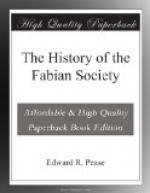universal attention. The early Suffrage movement
was mainly Socialist in origin: most of the first
leaders of the Women’s Social and Political
Union were or had been members either of the Fabian
Society or of the I.L.P. and it may almost be said
that all the women of the Society joined one or more
of the Suffrage Societies which for the next seven
years played so large a part in national politics.
But besides the question of the vote, which is not
peculiar to Socialism, there is a very large group
of subjects of special interest to Socialist women,
either practical problems of immediate politics relating
to the wages and conditions of women’s labour
and the treatment of women by Education Acts, National
Insurance Acts, and Factory Acts; or remoter and more
theoretical problems, especially those connected with
the question whether the wife in the ideal state is
to be an independent wage-earner or the mistress and
manager of an isolated home, dependent on her husband
as breadwinner. Efficiently organised by Mrs.
C.M. Wilson, until ill-health required her resignation
of the secretaryship in 1914; by Mrs. Bernard Shaw,
Mrs. Pember Reeves, Miss Murby, Miss Emma Brooke, and
many others, including in later years Dr. Letitia Fairfield,
the Group has had many of the characteristics of an
independent society. It has its own office, latterly
at 25 Tothill Street, rented from the parent Society,
with its own paid assistant secretary, and it has issued
for private circulation its own publications.
In 1913 it prepared a volume of essays on “Women
Workers in Seven Professions,” which was edited
by Professor Edith Morley and published by George
Routledge and Sons. It has prepared five tracts
for the Society, published in the general list, under
a sub-title, “The Women’s Group Series,”
and it has taken an active part, both independently
and in co-operation with other bodies, in the political
movements specially affecting women, which have been
so numerous in recent years.
* * * *
*
It will be recollected that the only direct result
of the Special Enquiry Committee, apart from the changes
made in the organisation of the Society itself, was
the decision to promote local Socialist Societies
of the Fabian type with a view to increasing Socialist
representation in Parliament. I have recounted
in a previous chapter how this scheme worked out in
relation to the Labour Party and the running of candidates
for Parliament. It remains to describe here its
measure of success in the formation of local societies.
The summer of 1905 was about the low-water mark of
provincial Fabianism. Nine societies are named
in the report, but four of these appeared to have
no more than a nominal existence. The Oxford University
Society had but 6 members; Glasgow had 30 in its University
Society and 50 in its town Society; Liverpool was
reduced to 63, Leeds and County to 15, and that was
all. A year later the Cambridge University Society




